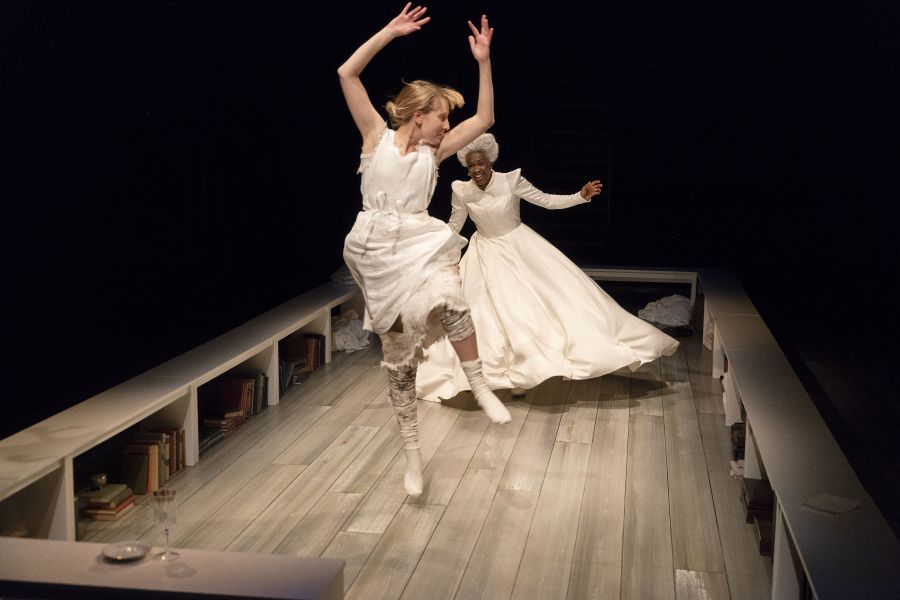MIKE KEENAN
What to make of the Shaw Festival’s The Baroness and the Pig?
My guess is that it will either infuriate you or cause you to think long and hard after viewing it. The production in the small Jackie Maxwell Studio Theatre puzzled me immediately. After five minutes, I thought ? my goodness, this is going to be a long, tedious play, but in the next few minutes, I thought ? okay, I get it; it’s an interesting satire on who is teaching what to whom. And at the end ? wow, you can cut the black humour with a sharp knife, which is precisely how it finishes — with a sharp knife.
The premise, like the entire play, is preposterous. Surely, not Professor Henry Higgins on a wager, instructing Liza Doolittle how to speak proper English in Pygmalion. No, far darker than that, sometimes clever and sometimes befuddling. And that’s what I think Montréal playwright Michael Mackenzie has deliberately constructed ? something to make the viewer uncomfortable like O’Neill does in Stratford’s Long Day’s Journey Into Night. With Mackenzie, it’s not about alcohol and morphine. It’s about human nature and the fact that we have evolved from animals, clever animals like the pig that shares 98 per cent of our genetic makeup, yet likes to wallow in filthiness, an unwholesome trait that we discover is shared by an unseen character in this play.
The plot centres on a 19th century prim and naïve baroness who has deliberately and vainly selected her next maid, an unlikely feral girl (Julia Course), who barely speaks and is content to laze about in a pig sty. She names her Emily after Emile, Jean-Jacques Rousseau’s 1762 edict on education and child-rearing. How would Henry Higgins do? Not well, I suspect, but the baroness (Yanna McIntosh), like Dr. Frankenstein, is overly confident that her socialization techniques will work. This gets funny early on when she tries to outfit Course in fashionably heeled shoes versus farm boots. Course resembles an uncoordinated child trying on skates for the first time.
Alas, things did not work out so well for Dr. Frankenstein, nor do they go smoothly for the governess who must contend with an animal (yes, we even have a satire here on evolution let alone George Orwell), that finds it difficult to assume homo erectus status, content to worm her way around the stage and even up into the audience, sniffing, licking and grunting along the way, much to the consternation of her instructor. Course is simply incredible in her use of body language. Impossible to dismiss, she is a true force of nature that bends but will not break. Her actions and reactions are mesmerizing and not lost on McIntosh who admits that as an animate creature herself, she is dead ? “dried up.” Through interactions with Course, the two learn to sing and dance, but all along, Mackenzie stabs us with servile sentences like, “Will that be all, Madame?” ? at once funny yet ironic given the master/servant relationship ? much like a slave in U.S. cotton-growing states.
The casting and costumes double down on the darkness. McIntosh is Afro-American, and her white, crinoline-like flowery dress along with her white wig contrast sharply with both her black skin colour and our learned cultural conception of good and evil expressed in shades of black and white, white the symbol of purity and black equated with evil and original sin. Course is appropriately outfitted in white rags besotted with dirt.
The set design by Camellia Koo under director Selma Dimitrijevic, I did not quite get. It reminded me of a tiny gymnasium inside benches that housed books and other items underneath. A school connection I suppose, and yes, the area is restricted for McIntosh while Course runs and squirms about freely as the action unfolds in a sequence of short, jarring episodes punctuated by blackouts and shrill noise.
The play ends with an uneasy friendship that evolves between the two characters and Course who exacts payback to another beast, leaving us to figure out what it means to be “civilized” and to be human.
A few exceptional parts in the play relate to McIntosh teaching Shakespeare’s Julius Caesar to Course who follows behind her with a knife in her raised hand imitating Casca and others in the assassination scene, and later when Course deliberately cuts her own hand and persuades McIntosh to lick the blood as in a primitive Christian church ritual.
Good and evil, appearance and reality, nature and nurture, animalistic behaviour versus civilization, education and subjugation, male power and female subservience ? Michael Mackenzie has inserted all of these conflicting themes into this problematic play, which evokes bloody revolution against injustice in all of its forms whether it’s a bullying American politician, a presumptuous aristocrat or a celebrity rapist.
Did I enjoy this work? You bet, but it’s not for everyone.
The Baroness and the Pig by Michael Mackenzie, directed by Selma Dimitrijevic plays in the Jackie Maxwell Studio Theatre until October 6. ShawFest.com or 905-468-2172.
Mike Keenan is a Niagara on the Lake resident who writes poetry, humour, travel, performing arts pieces and podcasts ? all available on his website at www.whattravelwriterssay.com He has been published in newspapers and magazines throughout North America.










